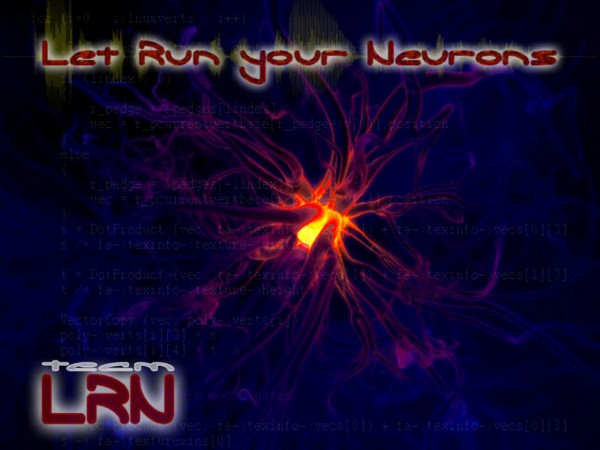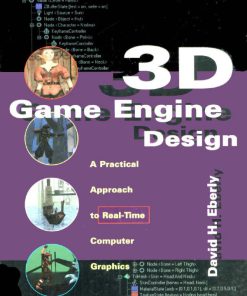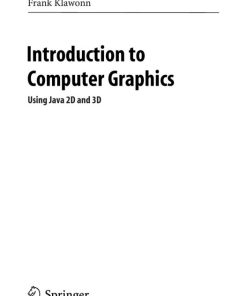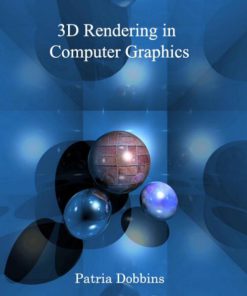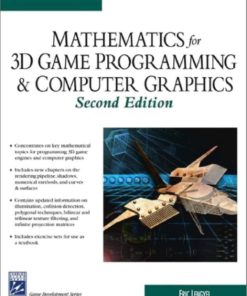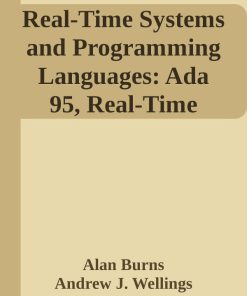3D Game Engine Design A Practical Approach to Real Time Computer Graphics 2nd Edition by David Eberly ISBN 0122290631 9780122290633
$50.00 Original price was: $50.00.$25.00Current price is: $25.00.
Authors:David H. Eberly , Series:Gaming [89] , Author sort:Eberly, David H. , Languages:Languages:eng , Published:Published:Jun 2000 , Publisher:Morgan Kaufmann Publishers
3D Game Engine Design A Practical Approach to Real Time Computer Graphics 2nd Edition by David Eberly – Ebook PDF Instant Download/Delivery. 0122290631 ,9780122290633
Full download 3D Game Engine Design A Practical Approach to Real Time Computer Graphics 2nd Edition after payment

Product details:
ISBN 10: 0122290631
ISBN 13: 9780122290633
Author: David Eberly
The first edition of 3D Game Engine Design was an international bestseller that sold over 17,000 copies and became an industry standard. In the six years since that book was published, graphics hardware has evolved enormously. Hardware can now be directly controlled through techniques such as shader programming, which requires an entirely new thought process of a programmer.
In a way that no other book can do, this new edition shows step by step how to make a shader-based graphics engine and how to tame this new technology. Much new material has been added, including more than twice the coverage of the essential techniques of scene graph management, as well as new methods for managing memory usage in the new generation of game consoles and portable game players. There are expanded discussions of collision detection, collision avoidance, and physics―all challenging subjects for developers. The mathematics coverage is now focused towards the end of the book to separate it from the general discussion.
As with the first edition, one of the most valuable features of this book is the inclusion of Wild Magic, a commercial quality game engine in source code that illustrates how to build a real-time rendering system from the lowest-level details all the way to a working game. Wild Magic Version 4 consists of over 300,000 lines of code that allows the results of programming experiments to be seen immediately. This new version of the engine is fully shader-based, runs on Windows XP, Mac OS X, and Linux, and is only available with the purchase of the book.
3D Game Engine Design A Practical Approach to Real Time Computer Graphics 2nd Edition Table of contents:
Chapter 1: Introduction to Real-Time Computer Graphics
- Understanding Real-Time Graphics
- History and Development of 3D Engines
- Key Components of a 3D Game Engine
- Game Development Frameworks
Chapter 2: Foundations of 3D Graphics
- Basic Geometry and Coordinate Systems
- Transformations: Scaling, Rotation, Translation
- The Graphics Pipeline: Stages and Concepts
- Overview of 3D Rendering Algorithms
Chapter 3: The Architecture of a 3D Game Engine
- Game Engine Components: Core Systems
- Handling Game Loops and States
- Scene Management and Object Hierarchy
- Engine Design Patterns: Modularization and Optimization
Chapter 4: Rendering Techniques and Optimization
- Rendering 3D Models and Textures
- The Role of Shaders and Materials
- Lighting Models and Techniques
- Performance Optimization Strategies for Real-Time Rendering
- Level of Detail (LOD) and Culling Techniques
Chapter 5: Handling 3D Models and Animation
- Importing 3D Models: File Formats and Converters
- Skeletons and Rigging in Animation
- Keyframe Animation vs. Procedural Animation
- Animation Blending and Transitions
- Managing Bone Hierarchies and Skinning
Chapter 6: Physics and Collision Detection
- Fundamentals of Physics in Games
- Rigid Body Dynamics and Simulations
- Collision Detection Algorithms: Bounding Boxes, Ray Casting, and More
- Handling Continuous Collision and Timestep Issues
- Integrating Physics with the Game Engine
Chapter 7: Camera Systems and View Management
- Camera Models in 3D Space
- Implementing First-Person, Third-Person, and Overhead Cameras
- Camera Control and Navigation Systems
- Depth and Perspective in 3D Graphics
- View Frustum Culling and Clipping
Chapter 8: Input Handling and User Interaction
- Handling Keyboard, Mouse, and Controller Input
- Managing Events and User Actions
- Camera Control via User Input
- Implementing GUI and HUD in 3D Games
Chapter 9: Audio and Sound in 3D Games
- Basics of Sound Programming for Games
- 3D Sound Localization and Doppler Effects
- Sound Effects and Music Integration
- Optimizing Audio for Performance
- Managing Sound Sources and Audio Channels
Chapter 10: Artificial Intelligence in Game Engines
- AI for Pathfinding and Navigation
- Steering Behaviors and NPC Movement
- Finite State Machines for AI Characters
- Decision-Making and Behavior Trees
- Using AI to Enhance Game Interactivity
Chapter 11: Networking and Multiplayer Support
- Introduction to Networking for Games
- Client-Server vs. Peer-to-Peer Architectures
- Handling Real-Time Multiplayer in 3D Environments
- Synchronization and Lag Compensation
- Networking APIs and Protocols
Chapter 12: Scripting and Extending the Engine
- Scripting Languages for Game Engines
- Writing Custom Game Logic and Extensions
- Tools for Debugging and Profiling
- Extending the Engine with Plugins and Modules
- Integrating AI, Physics, and Special Effects
Chapter 13: Cross-Platform Game Engine Design
- Designing for Multiple Platforms: PC, Consoles, and Mobile
- Handling Device-Specific Differences
- Cross-Platform Development Tools and Libraries
- Managing Game Engine Portability
- Testing and Debugging Across Platforms
Chapter 14: Finalizing and Optimizing the Game Engine
- Performance Tuning and Memory Management
- Real-Time Profiling and Debugging Techniques
- Stress Testing and Load Balancing
- Tools for Analyzing Engine Performance
- Final Optimization Tips for Shipping a Game
People also search for 3D Game Engine Design A Practical Approach to Real Time Computer Graphics 2nd Edition:
3d game engine design
3d game engine programming
3d game engine development
beginner 3d game engine
You may also like…
eBook PDF
3D Rendering in Computer Graphics 1st Edition by Patria Dobbins ISBN 0131788724 9788132342649

